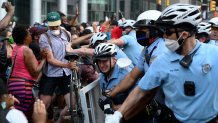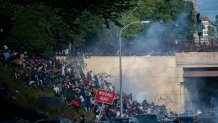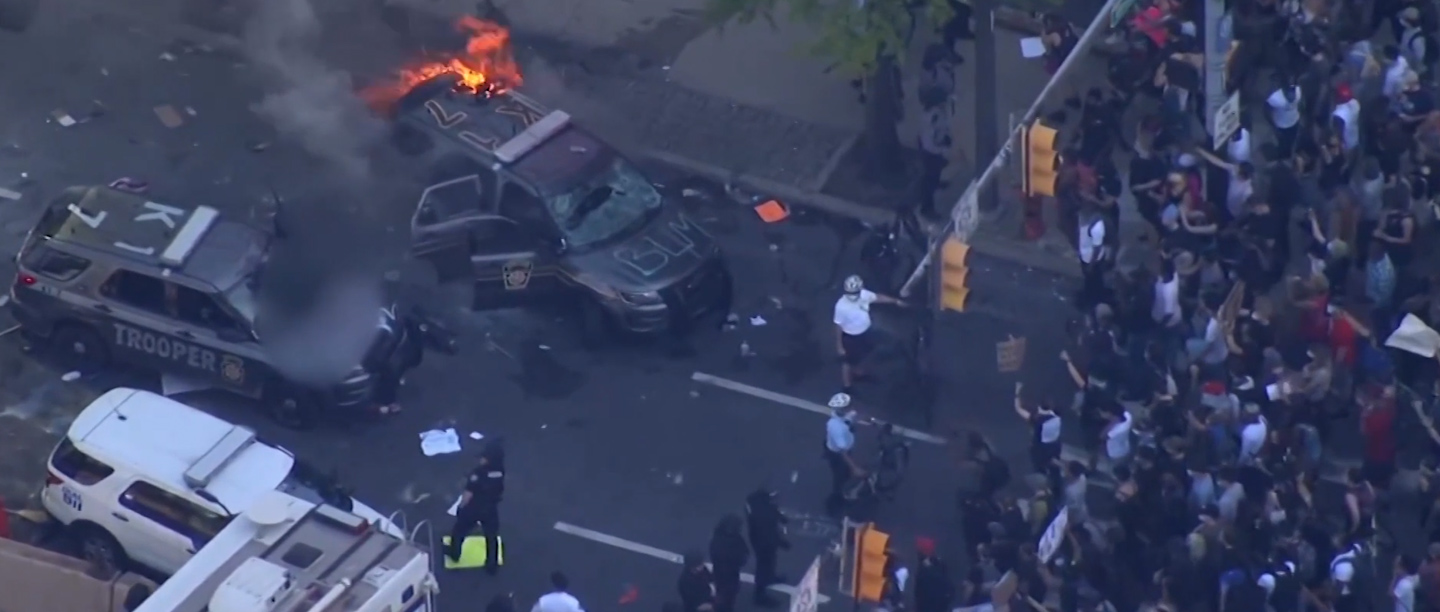When Jamila Hankinson saw the news about George Floyd’s murder last May, she was overcome with emotion.
“I felt like it was Trayvon Martin all over again. I couldn't stop crying,” Hankinson, a Philadelphia school teacher, said.
People throughout the country felt the same way. And in the days that followed Floyd’s death, protests and civil unrest broke out in cities across the country.
In Philadelphia, Police Commissioner Danielle Outlaw had been on the job three months. She watched as other cities struggled to contain the civil unrest and violence.
“It was cause for some alarm,” Outlaw said.
But that alarm wasn’t enough to order extensive protest and civil unrest planning.
Two recently released independent reports blame Outlaw and other city officials for not doing enough to prepare for the unrest that eventually hit Philadelphia – causing millions of dollars in property damage and injuring 104 police officers and an unknown number of civilians.
Police body camera footage obtained exclusively by NBC10 shows how unprepared and ill-equipped police were in responding to the protests that ultimately turned violent.
In an interview with NBC10, Outlaw said that she didn’t think such unrest would happen in Philadelphia. Other police and city officials, she said, told her that historically the city had peaceful protests and that looting and civil unrest wasn’t a thing that happened.
“I had no reason to believe that what they were saying wasn’t true,” she said.
Indeed, just one day before the first protest, Mayor Jim Kenney expressed confidence that order would be maintained.
“Our only rules are you can protest as loud and as long as you want, but the damage, the destruction of property or hurting someone else will not be permitted. But we’re very well-schooled, from the [2000] Republican National Convention onward, on how to handle these events," Kenney told reporters. "We’ll be respectful and we expect people to be respectful and to express their anger, express their concern, and we’ll all work together to have a safe day."
But one of the reports ordered by the City Controller noted that following the death of other black men at the hands of police, Philadelphia had prepared for unrest – including calling mounted patrol and anti-looting teams. And even for the Super Bowl parade, more than 1,000 cops were assigned and plans were put in place for areas where people might set cars on fire or engage in vandalism.
May 30
Police knew that a protest of up to 3,600 people was expected May 30. It wasn’t until that morning that Outlaw saw the protest plan for the first time: 53 officers assigned.
“The second I saw that, that’s when I got on the horn and we started to do everything that we could to bolster the numbers,” she said.
But by then, it was too late. Without advance notice, it was difficult to mobilize more officers.
Meanwhile, Hankinson headed out for a day of protesting.
She carried a sign that read: “I'm an angry black woman, stop murdering our sons and husbands.” She joined hundreds others at the Art Museum.
At first, the protest was peaceful.
“It was just people hugging and showing their signs and things like that,” Hankinson said.
But when the protest got to City Hall and the Municipal Services Building, people started lighting police cars on fire and trying to pull down the Frank Rizzo statue.
“That day I kept saying, wow, these police are showing tremendous restraint,” Hankinson said.
Exclusive police body camera footage obtained by NBC10 shows how officers lined up in front of the Municipal Services Building were struggling to control the crowd.
As police cars were going up in flames less than a block away, Sgt. John McBride lamented that the officers themselves were not enough.
“The National Guard should have been here. This is ridiculous,” he said.

Because of lack of prior planning for potential unrest, not all officers were equipped with shields or riot helmets. Some had to duck as flying bottles came over the police line.
“It was a lot to see that – [police] treated that way. I did feel bad for the police officers that day,” Hankinson said, adding that she went home once the violence was escalating.
McBride was still helping hold the line in front of the MSB, hoping he would get more officers to help.
“We need backups,” he told another officer, as he pointed to the officers on the front line. “This single line here with no shields.”
In the body camera video, the police radio crackles every few seconds with increasingly bad news:
“Looks like they gained entry to City Hall.”
“Looting at Apple store at 15th and Chestnut.”
“More units to 1500 Chestnut and Walnut. All stores are getting broken into.”
May 31
On the second day of protests, Outlaw met with Mayor Jim Kenney to discuss the use of tear gas.
According to the controller’s report, Kenney said he was personally against the use but left the decision to Outlaw – if she thought it was absolutely necessary.
Outlaw had experience with using tear gas against protestors from her time leading the police department in Portland, but Philadelphia’s SWAT team had not used tear gas for any sort of civil unrest since the 1985 MOVE bombing.
She didn’t think twice about their inexperience in using the chemical against crowds.
“There was no reason for me to question at that time or have any lack of confidence in their ability, given that they're all full-time SWAT operators,” Outlaw said.
So, Outlaw gave the approval for SWAT to use tear gas and other less lethal munitions – pepper pellets and bean bag rounds – on 52nd Street between Chestnut and Market streets, where people were setting police cars on fire and looting stores.
But the SWAT team threw gas canisters down residential streets all the way down to Spruce Street.
Still, police used tear gas twice more: again that night in Kensington, and the next day on Interstate 676 in Center City.
June 1
"It's pretty clear in Philadelphia that things went very, very poorly at every level from planning to use of force."
Gil Kerlikowske, former Seattle police chief
Hankinson was once again marching on the third day of protests when the group veered off from the Benjamin Franklin Parkway onto I-676.
Before she could get down to the expressway herself, there was a panic in the crowd below.
“You just saw the whole crowd of the people trying to get away, but there was no way to get away,” Hankinson said. “There was nowhere to run but up the hill.”
The protestors had been met with tear gas.

People were trampling one another as they ran up the hill and tried to climb over a metal fence. Many were trapped in the tear gas smoke – or struck by pepper pellets and bean bags.
“It was horrible,” Hankinson recalled.
Hankinson and her sister were eventually surrounded in a cloud of tear gas, coughing and struggling to breath.
Gil Kerlikowske is a former Seattle police chief who also served as the U.S. Customs and Border Protection commissioner. He reviewed one of the reports on the Philadelphia Police Department's response to the protests and unrest.
“It's pretty clear in Philadelphia that things went very, very poorly at every level from planning to use of force,” he said.
He also noted that tear gas is “falling out of favor” with many police departments throughout the country. It’s hard to control in crowd situations. Pepper spray is the better alternative for crowd control, he said.
The so-called rubber bullets, which in Philadelphia are plastic pellets and bean bag rounds, are also a hazard, Kerlikowske said.
“You probably want to stay away as much as you can from those kinds of munitions,” he said.
The Future of Tear Gas
City Council passed a bill last fall banning the use of tear gas and other less lethal munitions against protestors. And while Mayor Kenney signed it, he noted that Council doesn’t have the authority to dictate how the police department operates.
Nevertheless, Kenney said, the department already prohibits use of force against peaceful demonstrators.
He noted “the distinction between constitutionally protected activity, on the one hand, and unlawful destruction of property or violence, on the other.”
“Once that line is crossed, the bill’s prohibition does not apply,” Kenney said, adding that the department will use whatever means necessary to neutralize any threats.
Outlaw still defends her initial decision to use tear gas in West Philadelphia.
“What I had seen and what was explained to me was not peaceful at that time,” she said.
And, although she’s apologized for the use of tear gas on I-676, she still hasn’t come to a conclusion on that incident.
“All of that debris that we saw on the ground wasn't all police debris. Something happened. My question is, when did that happen and what was our response when we saw it occurring?”
She said she is awaiting the results of several internal investigations.
Meanwhile, Hankinson joined one of several lawsuits accusing the city of excessive use of force during last year’s protests. She is hoping the lawsuits lead to positive change within the police force.
“They need more training, proper training, just how to interact with people in a different way,” she said.
But mostly she is frustrated with how long it takes to cement change in how police treat residents.
“I'm 50 years old and my parents marched for the same exact things when they were my age,” Hankinson said. “So we have now three generations protesting for protection and to be treated fairly by the police. That makes no sense to me. Like at what point do we address the issue?”

